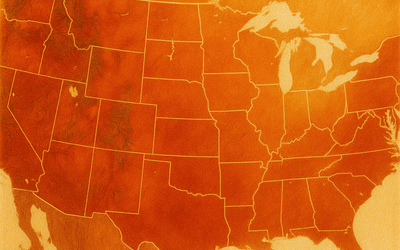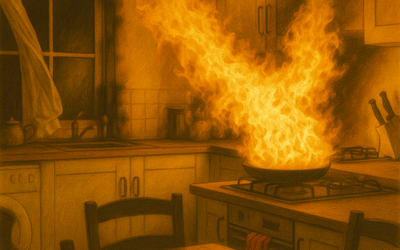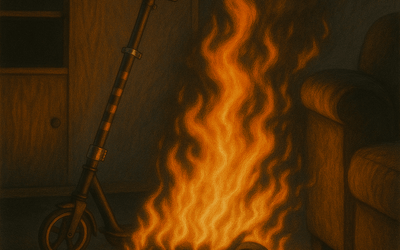You're standing in your workshop, welding torch in hand, when a spark catches something it shouldn't. The temperature climbs past 1,000°F in seconds. Your standard fiberglass fire blanket hangs on the wall, but will it handle heat this intense? This question kept me up nights during my early firefighting days, especially after seeing blankets fail when people needed them most.
After 20 years responding to fires ranging from kitchen grease flare-ups to industrial chemical blazes, I've learned that choosing between silicone and fiberglass fire blankets isn't about which one's "better." It's about matching the tool to your specific fire risks. Let me walk you through exactly when silicone becomes your best option.
Understanding the Material Difference
Before we dive into specific scenarios, you need to understand what sets these materials apart. Standard fiberglass fire blankets, like the ones at fireblanket.com, work brilliantly for most household fires. They're made from woven glass fibers that can handle temperatures up to 1,076°F (580°C), meeting the UL 94 standard for fire suppression.
Silicone fire blankets take protection further. They combine a fiberglass core with a silicone rubber coating, pushing temperature resistance up to 2,012°F (1,100°C) or higher. But here's what the spec sheets don't tell you: silicone blankets stay flexible after extreme heat exposure, while plain fiberglass can become brittle.
Think of it like comparing a leather work glove to a welding glove. Both protect your hands, but you'd grab the welding glove for specific high-heat tasks.
Temperature Thresholds That Matter
Let's talk real numbers, because fire doesn't care about marketing claims.
| Fire Type | Typical Temperature | Blanket Recommendation |
|---|---|---|
| Cooking oil fire | 700-1,000°F | Fiberglass works fine |
| Wood/paper fire | 800-1,100°F | Fiberglass handles it |
| Gasoline fire | 1,500°F | Silicone recommended |
| Magnesium fire | 3,000°F+ | Silicone (with caution) |
| Lithium battery | 2,000°F+ | Silicone essential |
These aren't just numbers on a chart. I've seen a standard blanket work perfectly on a stovetop grease fire, then watched another one struggle with a small gasoline spill in a garage. The difference? Temperature.
Specific Situations Calling for Silicone
Professional Welding and Metal Work
If you run a welding shop or do serious metalwork at home, silicone becomes non-negotiable. Welding arcs reach 10,000°F at the tip, and while you're not throwing a blanket on the arc itself, nearby materials can ignite at much higher temperatures than typical household fires.
I responded to a call where a welder's spark caught insulation behind a wall. The fire spread inside the wall cavity, reaching temperatures that would have overwhelmed a standard blanket. The shop's silicone blanket contained the external flames long enough for us to cut into the wall and stop the spread.
Commercial Kitchens and Deep Fryers
Commercial fryers operate at 350-375°F, but when oil ignites, temperatures skyrocket past 1,000°F instantly. Add in the splashing risk when deploying a blanket, and silicone's smooth surface becomes crucial. It won't absorb oil like exposed fiberglass might.
Restaurant owners often ask me about blanket placement. Mount your silicone blanket within arm's reach of the fryer, but not directly above it where rising heat could degrade the storage container over time.
Automotive and Marine Applications
Modern vehicles pack serious heat sources: turbochargers hit 1,000°F, exhaust systems glow at 1,200°F, and performance brakes can exceed 1,500°F. If you work on cars or store them with others, silicone protection makes sense.
Boats face unique challenges. Salt air corrodes standard fiberglass faster than silicone-coated options. Plus, engine compartment fires burn hotter in confined spaces. The NFPA 302 standard for recreational boats recognizes these elevated risks.
Chemical and Laboratory Environments
Some chemicals burn at extreme temperatures or create corrosive byproducts that attack standard fiberglass. Silicone's chemical resistance protects against acids, bases, and solvents that might compromise other materials.
University labs I've inspected typically stock silicone blankets near fume hoods and chemical storage areas. It's not just about temperature; it's about maintaining blanket integrity when exposed to chemical vapors over time.
Home Scenarios That Might Warrant Silicone
Most homes do fine with quality fiberglass blankets. But certain situations change the equation:
Home Workshops with Multiple Heat Sources
You might think your basement workshop doesn't need commercial-grade protection. Reconsider if you have:
- Welding equipment (even small MIG welders)
- Torch sets for jewelry or metalwork
- Kilns or forges
- Multiple power tools that generate heat
- Stored fuels or chemicals
One blanket type can't cover every risk. I keep fiberglass in my kitchen and silicone in my garage workshop.
Electric Vehicle Charging Areas
EV battery fires burn differently than gas fires. They reach 2,000°F and can reignite hours later. While full EV fires need professional response, a silicone blanket can help contain small battery incidents before they escalate.
Mount one near your charging station, especially if you charge in an attached garage. The peace of mind alone justifies the investment for many EV owners I've talked with.
Outdoor Cooking Enthusiasts
Love your smoker, pizza oven, or outdoor kitchen? These reach temperatures that push fiberglass limits. A silicone blanket handles the heat better and withstands weather exposure between uses.
Pro tip: Store outdoor blankets in waterproof containers. Even silicone-coated blankets work best when dry.
Reusability and Durability Factors
Here's something manufacturers don't always clarify: reusability depends on exposure type, not just material.
Standard fiberglass blankets often work once for serious fires. The glass fibers fuse together under extreme heat, making the blanket stiff and less effective for future use. They're designed as single-use for significant fires, though they handle multiple small incidents fine.
Silicone blankets maintain flexibility after heat exposure, potentially allowing multiple uses even after serious fires. I've tested blankets that survived five controlled 1,500°F exposures while maintaining effectiveness.
Remember: Any blanket used on a serious fire should be professionally inspected or replaced. Your life isn't worth gambling on compromised equipment.
Cost Analysis and Return on Investment
Silicone blankets cost 3-5 times more than fiberglass options. When does that investment pay off?
Professional Settings
Calculate potential losses from fire damage, business interruption, and liability. A $200 silicone blanket becomes cheap insurance against a $50,000 equipment loss or million-dollar lawsuit.
One welding shop owner told me his silicone blanket paid for itself by preventing one small fire from spreading to $30,000 worth of customer vehicles.
Home Use Cost-Benefit
For most homes, quality fiberglass provides excellent protection at reasonable cost. Upgrade to silicone when:
- Your activities involve temperatures above 1,000°F regularly
- You need chemical resistance
- Outdoor exposure demands weather resistance
- Multiple family members need fire protection training (silicone survives repeated practice better)
Size and Application Considerations
Silicone's weight affects deployment. A silicone blanket weighs 40-50% more than equivalent fiberglass, which matters for quick response.
Standard home sizes (39"x39") work for most applications. But consider larger options for:
- Vehicle fires (minimum 6'x8')
- Industrial equipment (custom sizes available)
- Training facilities (multiple sizes for various scenarios)
Mount brackets need stronger anchors for heavier silicone blankets. Test your mounting monthly, especially in high-vibration environments like garages.
Making the Right Choice
After two decades fighting fires, I've learned that the "best" fire blanket is the one that matches your actual risks. Here's my decision framework:
Choose Silicone When:
- You work with open flames above 1,000°F
- Chemical exposure is possible
- Outdoor storage is necessary
- Professional liability demands maximum protection
- You need guaranteed reusability
- Dealing with modern battery technology
Fiberglass Works Fine When:
- Kitchen fires are your primary concern
- Budget constraints exist
- Indoor storage in climate-controlled areas
- Residential use without special hazards
- Weight matters for quick deployment
Proper Training and Maintenance
The best blanket fails without proper training. Silicone's extra weight requires adjusted deployment technique:
- Pull tabs with more force than fiberglass
- Use both hands for control
- Practice the modified grip for heavier material
- Train all users on the weight difference
Maintenance differs too. Silicone resists moisture and chemicals better, but inspect for:
- Coating cracks or peeling
- Punctures that expose fiberglass core
- Degraded mounting hardware from extra weight
- Storage container integrity
Clean silicone blankets with mild soap and water after exposure to chemicals. Fiberglass typically can't be cleaned effectively after use.
Understanding Certifications and Standards
Both blanket types meet various standards, but certifications tell different stories:
EN 1869:2019 tests basic fire suppression for cooking oils. Most fiberglass blankets pass easily.
Higher Temperature Testing isn't standardized universally. Manufacturers test silicone blankets using modified protocols or internal standards. Ask for specific test data relevant to your application.
Verify certification marks before purchasing. I've seen imported blankets with fake certification stamps that failed basic heat tests.
Real-World Performance Stories
Lab tests tell one story. Real fires tell another.
A machine shop in Sacramento faced an oil-soaked rag fire that spread to hydraulic lines. Their fiberglass blanket initially contained the flames, but hydraulic fluid burns at 1,500°F. The blanket degraded within minutes. Now they stock silicone near all hydraulic equipment.
Conversely, I've seen restaurant owners spend thousands on silicone blankets for standard kitchen protection. Quality fiberglass would have served them perfectly at a fraction of the cost.
The key? Match protection to actual risk, not perceived risk.
Special Considerations for Specific Industries
Manufacturing and Fabrication
CNC machines using coolants face unique risks. Coolant mists can degrade fiberglass over time, while silicone resists breakdown. Factor in environmental exposure, not just fire risk.
Educational Institutions
Schools teaching welding or automotive programs need silicone for shop areas but standard fiberglass suffices for home economics kitchens. Budget accordingly.
Emergency Response Teams
First responders often carry silicone blankets because we face unknown fire types. Your home or business probably has predictable risks allowing specific blanket selection.
Future-Proofing Your Fire Protection
Fire risks evolve with technology. Twenty years ago, lithium battery fires weren't on anyone's radar. Today they're a growing concern.
Consider future changes:
- Adding an EV or home battery system?
- Planning a workshop expansion?
- Buying new cooking equipment?
- Changing business operations?
Sometimes investing in silicone now prevents upgrading later.
The Bottom Line
Choosing between silicone and fiberglass fire blankets comes down to matching protection to risk. Most homes need quality fiberglass blankets for kitchen and general fire protection. Silicone becomes essential when temperatures exceed 1,000°F regularly, chemicals pose risks, or professional liability demands maximum protection.
Don't overspend on protection you don't need, but don't skimp when facing serious fire risks. Assess your actual hazards, not worst-case scenarios, and choose accordingly.
Remember, the best fire blanket is one you know how to use properly. Whatever material you choose, practice deployment until it becomes automatic. When flames appear, muscle memory saves lives, not material specifications.
Take inventory of your fire risks today. List heat sources, chemicals, and activities that create fire hazards. Use this article's guidelines to determine if silicone protection makes sense for your situation. Your future self will thank you for thinking it through now, before you need it.





